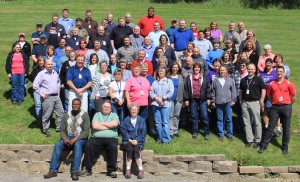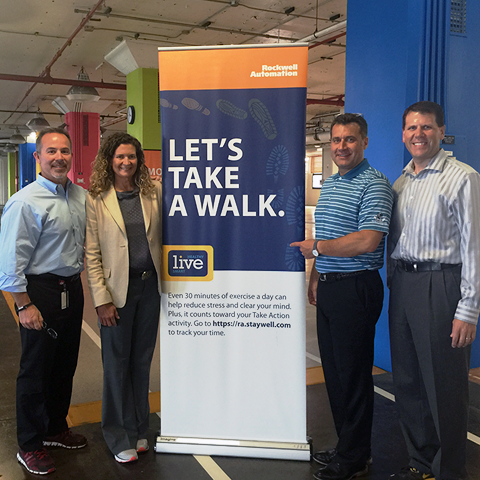FYB News
The Perks of a 67-lb Weight Loss
“Wow. You look different.”
Michael Frank, Firmware Quality Engineer in Milwaukee, is getting used to these words. After losing 67 pounds, Michael looks and feels different, and people are starting to notice. “Initially, people who hadn’t seen me in a couple months would notice. Just recently, it’s become noticeable for people who see me almost daily,” said Michael. “It feels great.”
Michael lost weight by joining Choose to Lose, an onsite weight-loss program offered in Milwaukee. “I knew I was getting a little too heavy,” he said. “I kept thinking I needed to do something and had a few false starts over the year. Then I saw an article about Choose to Lose and thought I should give that a try since nothing else was working.”
“The program was great. I liked the combination of having a wellness coach and personal training sessions,” he said. “It turned out be a nice combination so I could focus on fitness, as well as diet and lifestyle change. I like that part.”
At the end of the 14-week program, Michael lost 38 pounds, reduced his body fat, lowered his resting heart rate, lowered his blood pressure and improved his flexibility. Better yet, simple activities, like walking upstairs, became easier. “I feel more energetic, and I’m doing more,” he said. “I help coach my kids in lacrosse and football, and now getting on the field and running around to do what I have to do with them is a lot easier.”
Michael says the key to his success was focusing on his diet. “Learning how to eat healthier was helpful. Now, instead of a candy bar, I reach for a piece of fruit. But I think learning how to suppress those urges in the first place was the biggest help.”
Due to his success the first time, Michael signed up for a second round of Choose to Lose. He started in September and has lost an additional 29 pounds, bringing his total weight-loss to 67 pounds—and counting. “I’m updating my goals as I go along,” he said. “My initial goal was to lose 55 pounds. Now my next goal is to lose 17 additional pounds.”
Whatever he chooses, we know Michael will continue to look and feel great, improve his health, increase his energy and get more compliments.

Want to lose weight?
If you’re in Milwaukee or Mequon, consider the Choose to Lose weight-loss program. Watch your email toward the end of the year for information about the next session.
If you’re not in Milwaukee or Mequon, consider health coaching through StayWell. You’ll work one-on-one with a trained health coach to create a weight-loss game plan that’s right for you. Your coach will help you get inspired, find the right resources and make positive changes to your health. As a bonus, your health coaching counts as a Take Action activity and can help you save money on your medical premiums. To get started, call the StayWell Helpline at 1.800.721.2696.
Keep in mind that the other Take Action activities in our Health Management program can help you get active and eat better, which can also lead to weight loss.
Richland Center Getting Healthy for Life
Richland Center employees are eating healthier, moving more and losing weight. Many of them will see improvements in their Numbers@Work health screening results this fall and save money on their 2016 medical premiums as a result. That’s because in May the facility kicked off “Healthy Living for Life,” a six-month challenge inspired by Kimberly Haskins Anderson, LVMCC Team Leader.
“I found myself drinking too much pop and not exercising. My blood pressure was up, I was tired all the time and I had a lot of pain in my joints. But I just couldn’t get motivated to lose weight or eat the right thing,” said Kimberly. “A few of us at work talked about doing some kind of weight-loss or food challenges. So we approached management about doing something plant wide, and they were all for it. After all, what better way to lose weight and eat right than to have a plant-wide challenge?”
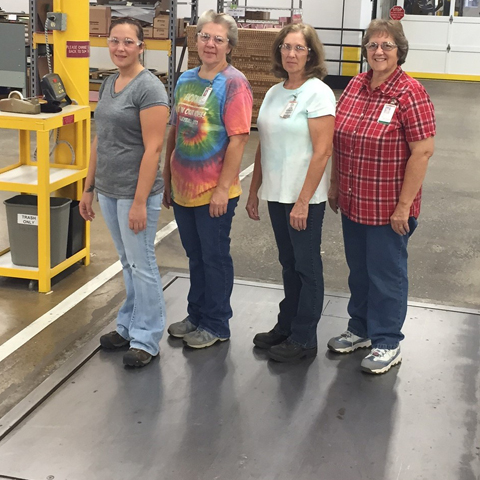
Photo: The Fat Busters team—Rachel Gruner (team captain), Darlene Doudna, Grace Gruner and Cheryl Hilby—weighs in on Richland Center’s shipping scale.
A Unique Approach
Richland Center has held weight-loss challenges before with limited success. So this time, the plant wanted to do something different. “We aligned the challenge with the fall health screenings, allowing employees to see health benefits and qualify for the premium discounts in the Health Management program,” said Eric Klang, Plant Manager. “This isn’t just about weight loss. It’s really a focus on healthy living.”
That aspect was appealing to Richland Center employees. When they invited everyone at the plant to join in, 129 people—about 35% of the plant—signed up. “It is so exciting to be part of a program that promotes the fact healthy living is a lifestyle, not a diet,” said Sandy Matteson, Warehouse Team Leader.
Another key difference is that much of Healthy Living for Life is employee-driven. Employees serve on the Steering Committee, which guides the program, and as team captains, attending captain’s meetings and reporting back to their teams. “I really like how everyone is involved and gets to give input,” said Rachel Gruner, Manufacturing Associate. “And that the program gives incentives for different challenges.”
Photo: Richland Center Healthy Living for Life participants (click photo to enlarge)
How It Works
To keep participants engaged and the program fresh, Richland Center added several popular features like monthly challenges and team weigh-ins. Here’s an overview:
- The Steering Committee sets monthly goals and challenges. Challenges inspire participants to do everything from exercising to drinking water and eating fruits and vegetables. For example, last month, participants could choose to try organic foods, eliminate sugar or count calories. The goal is to educate people to make these actions part of everyday living.
- People compete in teams for challenges and weight loss. There are 30 teams with three to four members each. Because it’s a team-based challenge, there are no individual weigh-ins. Team members weigh in together on the plant’s shipping scales.
- They earn points for prizes. Teams get points for losing weight and/or completing monthly challenges. The team with the most points each month gets $25 You ROKs for each member. The teams with the most points at the end will get a bigger prize. But it seems most people are participating for the camaraderie and motivation. “The challenges within this competition make the lifestyle easier to adapt to,” said Sandy.
- They have fun with it. The first challenge was to choose the best team name. Participants got creative with names like The Cereal Killers, Chunky Monkeys, The Fat & The Furious and Dump the Rump (the winning team name). The Steering Committee also keeps things upbeat by giving away Rockwell Automation water bottles.
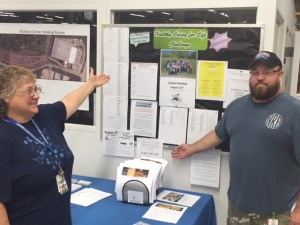
- They communicate a lot. There’s a Healthy Living for Life communication board in the plant. Employees can see the monthly and overall leaders, get free passes to local exercise facilities, find coupons for organic foods, learn about new weight-loss or fitness apps, share healthy recipes, and more.
- Participants get support but not advice.“We’ll tell them not to drink anything bad, and they’ll ask ‘what is bad?’ We’ll say we want you to look it up and make the decision for yourself. You decide,” said Sally Gald, Production Control Analyst. “We leave it up to the people to make the decisions because once the challenge is over, understanding what is good or bad is key.”
Photo: Team captains Kim Haskins Anderson (of team Well Rounded) and Todd Kaukl (of team Chisled) show off the communication board.
Results So Far
With time left to go on the challenge, employees have lost weight—580 pounds in the first three months!—and made impressive lifestyle changes. “I quit drinking Diet Pepsi. I used to drink about four to five bottles a day. I eat more fruits and veggies, and I exercise and walk more than ever before,” said Kimberly, a member of the Steering Committee. “I’m having fun, feeling better, eating good food and hoping to save money on my health insurance.”
She’s not the only one. “People hope to have better results on their screenings. You can see it. They put up the sign-up sheets early in August for the screenings. Nearly 150 signed up in the first week and the screenings aren’t until October,” said Noah Krachtt, Production Manager. “Attendance for the health screenings is going to be great this year.”
Given their efforts over the past month, there’s no question participants will see better numbers this year. But more important, they’ve adopted good lifestyle habits that will help them stay healthy for life.
If you have questions about the challenge or starting one at your location, feel free to contact Sally Gald or Eric Klang.
Our Sales Force Is Lighter on Their Feet
Nine members of our sales team met a wildly important goal this year: They lost 121 pounds.
Last fall, Andy Ramspott, Director of GSM Operations — NA Region, was inspired to make changes after his Numbers@Work health screening results were “not as lovely” as he would like. He and his colleague Mike Hermann started a friendly weight-loss competition with a unique wager. “I’m a Vikings fan and he’s a Packers fan and the loser was going to have to wear the other guy’s football jersey,” said Andy. Fortunately, both men met their goals and never had to pay up. But it sparked an idea.
At a staff meeting, Andy shared his new focus on diet, exercise and weight loss. He announced they were starting round two of the challenge and asked if anyone wanted to join. Nine people—just over half of this team—signed up.
“I joined because Andy had great progress in his first round, and he encouraged me to participate,” said Kurt Rosenberg, Director North America OEM business. “I’m glad I did. I’ve lost 20 pounds.”
For Jane Barr, Vice President of the Eastern Sales Region, the timing was perfect. She had listed “get healthy” as a goal on her personal PADR and thought the challenge could help. “As a working mom of two young boys, health, well-being and energy are so important,” she said. “I joined for the mutual accountability, and it was just what I needed. I tell Andy once a week that he changed my life.”
The Challenge
The Spring Slim-Down Competition ran from January through March. Participants set what the sales team calls a “WIG,” a wildly important goal, to lose five to 15 pounds by monitoring their steps and calories. “We met every week and talked about how you did against steps and calories and reported out on their weight change. And we’d update a graph of our progress and share that,” said Andy.
“The cool thing is we really got into making sure we got a lot of steps in,” said Andy. “When many of us have a meeting, we’d say, ‘Is there any reason we need to sit in an office? Can we walk and talk?’ A lot of times, if we’re at a break in a staff meeting, we’ll say, ‘Hey, let’s go for a few laps.’ And several people will walk and talk on conference calls.”
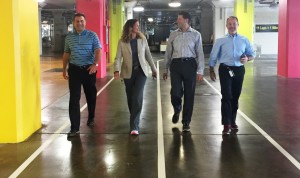
“Our walking meetings have provided a unique way to inspire energized and engaging discussions, proving far more efficient and effective than sitting across the office desk,” said Jane. “You’re walking side by side, moving in a common direction and often providing creative issue resolution and stronger alignment.”
Walking became such a regular activity that participants frequently brought walking shoes to the office. “All of us have a Fitbit or other tracking device, and several of us track our progress in the Step It Up challenge,” said Andy. All that walking helped him reach Step It Up’s 1.4 million-step goal in three months and drop 45 pounds along the way.
“We’ve also ordered healthier meals at our meetings, and we tend to make better choices,” he said. “None of us did anything radical. It’s just math—calories in and calories out. We’re just watching the calories coming in and making sure we’re burning more on a regular basis.”
“For me, understanding calories was key to losing weight,” said Kurt. “I’m also exercising daily. I track all my activities in my stepper program and what I eat in MyFitnessPal [a free calorie counter app].”
It was a simple process that yielded great results. “I’ve lost 14 pounds,” said Jane. “I’ve seen positives in all areas: I have higher energy, lower stress, an inspired attitude and my clothes fit better.”
“Another important outcome,” she continued, “is how this has affected my husband. He’s lost 42 pounds, motivated by our team’s success.”
Supporting Each Other
In addition to the weight loss, participants like the accountability and encouragement. “I like the group support and pressure to eat less and move more,” Kurt noted, adding that it’s common for members to share tips for eating healthy while traveling for business.
“I truly enjoyed the camaraderie,” added Jane. “The weekly calls drove the accountability, but also the support and best practice sharing, such as how to manage working out while managing a rigorous travel schedule and long hours.”
Along with the support comes some taunting. “We have a lot of razzing going on via text and email,” said Andy. “Jane will pull her steps graph up on her smartphone, put it in my window to show me where she is and say, ‘Where you at?’ We do stuff like that.”
That razzing continues as the group—which has now grown to 11 people—is in the middle of round three of the challenge. Best of all, they’ve adopted healthy habits that go beyond the challenge, create a healthier work environment and contribute to better health. And that’s also wildly important.
First photo (l to r): Joe Bartolomeo (Vice President, Central Region), Jane Barr, Kurt Rosenberg and Andy Ramspott.
Second photo (l to r): Kurt Rosenberg, Jane Barr, Andy Ramspott and Joe Bartolomeo occasionally hold meetings on Milwaukee’s indoor walking track.
Ladysmith Employees Reach 35 Million Steps!
In April, Plant Manager Teri Blumenthal and her staff decided to hold a walking challenge.
“We’re doing a lot on wellness for our facility,” said Teri. “Wellness is important to all of us and it was one of the things our employees talked about in Global Voices. They asked if we could do something, and the walking challenge is one of the things we did.”
They started the challenge by giving each employee at the Ladysmith facility a pedometer, explaining the challenge and describing the health benefits associated with exercise and walking. Using the “Walk Around the Facilities” theme, they encouraged associates to reach walking checkpoints at familiar Rockwell Automation locations. They also grouped employees into four teams based on their physical activity potential while at work: material handlers, general assembly, support staff and technicians/maintenance/injection molding.
“The response was phenomenal,” said Teri. “We had 60% participation.”
Each morning, someone from Teri’s team collected step counts from all the pedometers and tracked them in a centralized location. To make the competition fun, they also awarded prizes to the first employee to reach designated step checkpoints. From April to June, they awarded:
- 20 gift cards for smaller checkpoints
- 16 Fitbit trackers for larger checkpoints
- 4 grand prizes for the first employee in each group to reach 700,000 steps
The friendly competition was a great health and employee morale booster. And it led to amazing results. Ladysmith employees tracked more than 35 million steps between April and June! And their activity helps them qualify to earn up to $200 off their 2016 medical premiums.
Best of all, Teri says there’s a noticeable change at their location. “Everyone is thinking about wellness for many different reasons. With the walking challenge and Weight Watcher meetings, a lot of people are getting healthier and losing weight. It’s really cool,” she said. “We had a lot of fun with it, too. We’re going to keep doing different things to build the excitement and get the facility well.”
Winners (left to right): Wanda Read, Paul Goldbeck, Tavane Popp, Lynn Weingarten, Donna Mabie, Cheri Lambert, Kathy Lehman, Tiffany Guthrie, Joseph Makovsky, Liz Elam, Dan Bates, Pat Lynch, Sam Barg, Stacy Eichner. (Winners not pictured: Merri Marten, Lisa Moreau, Sandra Liazuk, Jeff Hayden, June Pavlik)
Start a Walking Challenge at Your Location
You can do the Rockwell Automation Walking Challenge on your own or with a group. Simply choose one of the five walking challenges and print your tracking map from ra.staywell.com.
- 100 Miles in 100 Days
- Rockwell Automation Sales Office
- ROK Around the World
- Mayfield ROKs
- Rockwell Automation Operations
Just remember: Any physical activity counts. You can use the conversion chart found on the back of your tracking map to convert your activities into steps. To complete this activity for $100, you need to walk the equivalent of 700,000 steps. Once you complete your challenge, log in to the StayWell website to report your completion.
Who Says Weight Loss Can’t Be Fun?
Twelve employees in Sourcing and Operational Purchasing have lost a total of 100 pounds since January—thanks to their Fun Committee’s friendly weight-loss competition. Although the competition isn’t over yet, it’s already inspired healthy lifestyle changes that will last long after the winner is announced.
How they got started
Their Fun Committee was formed a couple of years ago as a way to help colleagues in Sourcing and Purchasing get to know each other. “In the beginning, we would do a lot of potlucks, pie baking contests and cookie exchanges,” said Christine DiPiazza, Supply Management Team Lead, Strategic Sourcing Organization. “Eventually people started to suggest getting out of the office and doing something other than eating. So I thought a competition might be a fun way to help myself lose weight after maternity leave, and people liked the idea.”
The competition kicked off in January, which was perfect timing for Hal Kain, Supplier Manager, Strategic Sourcing. “Honestly, I joined due to the results from my Numbers@Work health screening,” he said. “For the first time I was beyond borderline. So I was already thinking along those lines when this came up. I thought it would be a good motivator.”
How the competition works
The Fun Committee put a lot of thought into setting up the competition. “We talked about how to optimize it so people wouldn’t be afraid to join in,” said Christine. “We did it anonymously, assigning everyone a number, so only one person knows what everyone weighs. We helped generate more interest because we were able to keep it private.”
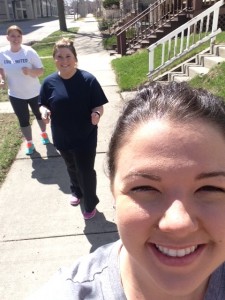
Participants weighed in on the same scale at the start of the competition and will weigh in on the same scale when the competition ends around Memorial Day. For monthly check-ins along the way, participants can weigh themselves and email their weight to the trusted weight keeper. The weight keeper then emails percentages and pounds lost to the group.
Initially, the Fun Committee planned to offer programs and events just for participants, including daily walks, lunch and learns with nutrition and fitness experts, weekly motivational emails and tips, and invitations to friend each other on popular fitness apps like Fitbit. But those features were so popular that they ended up opening them up for anyone to participate.
“We get emails on a regular basis with healthy recipes,” said Hal. “I’ve taken some of those home, and my wife has fixed them. I’ve also participated in some of the daily walks.”
How they’re doing
The formula seems to be working. Participants are losing weight and having fun along the way. “I really appreciate that the Fun Committee put this together. It gave me the opportunity to add some camaraderie with the others and, to be honest with you, the competition is kind of fun,” said Hal. “Watching what others do motivates you to do a little more. I think that’s a big benefit.”
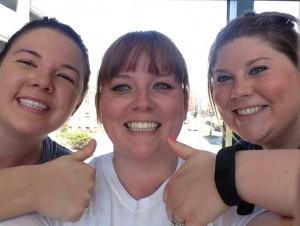
The group motivation has inspired numerous lifestyle changes among the group. “Four of us have started training for a 10k in June, and we run on our lunch break,” said Christine.
“I started an exercise program with a health club that also offers training on nutrition. I’ve been tracking my daily food intake on the My Fitness Pal app and started changing my eating habits,” said Hal. “I’ve seen huge changes both with my weight and stamina. Physically, I’m getting more muscular and my BMI has dropped considerably, so it’s all working together to help me feel better.”
“I have lost about 10 pounds,” added Christine. “I’m focusing on real changes that are going to last. I’m trying to drink less soda, running three times a week, going out to eat less and making all the smart choices instead of dieting and then falling off the wagon.”
The extra inspiration from the competition will certainly help. While we don’t yet know who will lose the most weight or how much the group will lose when the competition ends, one thing is clear: The secret to weight loss just might be to eat less, move more and make it fun.
Photos: Three of the 12 participants—Christine DiPiazza (white shirt), Kathryn Mankiewicz (blue shirt) and Hailey Lindner (gray shirt)—enjoy a group walk in April.
Want to lose weight? Get started with a Take Action activity, like the Step It Up challenge, Time Out for Health or the Rockwell Automation Walking Challenge. They’re designed to help you move more and eat better, which can help you slim down. And when you participate as part of our Health Management Program, you can earn up to $200 of your 2016 medical premiums, too.
Take Action Activity Inspires Lifestyle Change
What started years ago as a way to earn a $100 incentive has turned into a lifestyle change and a new challenge for Paul Larsen, Senior SAP Support Analyst (Milwaukee). After reaching 700,000 steps in the Step It Up challenge last year, he now aims to reach the top goal—1.4 million steps—before the year ends. That’s the equivalent of walking the Grand Canyon two and a half times … or the length of 12,320 football fields! And it could earn him $200 off his 2016 medical premiums, too.
We stopped to ask him what inspired him and how he plans to get it done.
You started with Get Fit on Route 66 and then moved on to Step It Up. What inspired you to do these programs in the first place?
First, you have a $100 incentive. So that’s a good way to start. But beyond that, sometimes it’s the smallest little things, like being able to track it and have a goal. To say, “I’m going to make the 700,000 steps.” It’s motivating to have that goal in front of you. And, if it’s logged in one spot, you’re not forgetting it. So I like being able to document the activity, have a financial goal and [get] the satisfaction of tracking it yourself to see what you’re doing. Those all work together.
You say Step It Up inspired you to be more active. What physical activities do you do?
I added walking big time since I started. I had been walking before, just not as consistently or as much. I also log other activities, like cutting the grass, but the main thing is walking. I also do some weight lifting when the weather isn’t good, so that was a secondary change in lifestyle.
How do you fit it in your busy schedule?
You have to take time to do it, just like you take time for lunch. That’s always a challenge, but in the end, we’re probably going to be more productive if we’re walking than if we’re just not exercising and sitting all day. In the end, we’re probably better off in every way, not just health wise but productivity wise as well.
How many steps do you aim for each day?
I really focus on time. I try to get in 30 or 40 minutes, and use the Step It Up website to convert my time to steps. I get 30 minutes at lunch. That’s the equivalent of 3,000 steps. I’m averaging in the 4,000-step range, but I’d like to get in 6,000 steps if I could. That’d be walking about an hour.
How do you keep it challenging year after year?
I only log technical exercise time, like the steps I do when I’m on the track. I don’t log when I’m walking to my car or anything like that [although the program allows you to]. I don’t want to do that because for me that’s not changing my lifestyle. If I log the steps I take anyway, that makes absolutely no difference. To me, it makes a difference if I’m doing something I wouldn’t have done before or if I’m intentionally exercising. That’s worth logging because you’re doing it for the purpose of getting in shape or being healthier.
Have you noticed any health benefits?
I don’t know that I noticed anything. Bottom line is my lifestyle changed. I think that’s the whole goal here. My exercise has increased.
Do you participate in other parts of the Health Management Program?
Yes. I really appreciate Rockwell Automation doing this—having the walking track [in Milwaukee] and even the little incentives. There are several things to choose. If you choose a healthy activity or lifestyle, they want to reward you and give you a way to log it. It’s a small little perk, but it’s really nice. I appreciate Rockwell Automation doing that.
Why do you want to reach 1,400,000 steps?
Having 1,400,000 steps as a goal is enough to keep you going all year. I would have gone for 1,400,000 steps last year if I started earlier. Last year I started around May and was still able to make the first goal (700,000 steps). But this year, I was motivated to start in January, and I’ve already logged in steps for the year.
What’s your motivation?
In the larger issue, $100 isn’t that big of a deal. The picture of health is the bigger issue. And the older we get, the science of being healthy is pretty undeniable on this. If you’re exercising, you’re just better off. So that is the bigger motivation. These other [incentives] are just little helps to get you going. The bigger goal is health. That is obviously more important.
Join Paul!
Start the Step It Up challenge today to see how many steps you can achieve before the year ends!
You can do any activity—like biking, basketball or exercise class—and easily convert it to steps with your Fitbit (which syncs to StayWell’s site), a pedometer or the online activity conversion tool. Complete the equivalent of 700,000 steps to earn a $100 credit toward your 2016 medical premiums. Or hit 1,400,000 steps to earn a $200 credit. The sooner you start, the more steps you’ll reach and the more likely you’ll achieve your own lifestyle change.
To sign up or learn more about any of the Take Action activities, log in to ra.staywell.com and click the Step It Up button.
How Bill Howell Took Control of Type 2 Diabetes
Bill Howell, a member of the Lean Six Sigma Core Team in Milwaukee, was diagnosed with Type 2 diabetes in October 2009. Although his physician speculates he had the condition for a lot longer, the first signs that something was wrong began six weeks earlier.
It started with what he describes as a never-ending thirst. From there, his symptoms expanded to include painful leg cramps, dry mouth, tongue swelling, vision changes, 40-pound weight loss and a partially paralyzed foot. “It came on quick. In about three weeks, I went from reading glasses to needing a magnifying glass to read the computer screen,” he said. “It was nothing debilitating—not like it’s the flu that just knocks you down—but it’s enough to get your attention that things aren’t quite right.”
Recognizing the symptoms, a former coworker cornered Bill at the office to make him test his blood glucose. “My reading was off the meter. It only goes to 600, and I was over 600, when it should be 100ish.” When he confirmed the diagnosis with his doctor, he learned his condition was quite serious. “When you get your blood drawn for a test, it should be in the 3.8 range to 6.8. I came in at 15.3. When I tell health care professionals that I was a 15.3, they stop whatever they are doing and look at me and say ‘were you in the hospital?’”
His Approach
Despite the numbers, Bill never felt sorry for himself. “I didn’t look at this as a disease. I looked it as a project and I would crush it with Six Sigma,” he said. “When you have these symptoms, you can’t walk right and you’re sleeping in one-hour increments because you’re going to the bathroom through the night, you make up your mind pretty fast that you can’t go on like this.”
“You make a plan, document what you’re going to do, record your data, analyze it and watch how the process improves over time,” he explained. His plan of attack included partnering with his physician; establishing a goal statement; drafting a storyboard (a Six Sigma method for documenting projects); and creating templates and charts to track his glucose tests, glucose meter calibrations, medication and food intake. His detailed plan, which is outlined in his e-book I Took Control (available on Yammer), allowed him to notice patterns and determine which factors had the largest impact on his health.
“Fundamentally, this is a function of what you eat,” he said. For the first six months, Bill measured, recorded and charted everything he ate, including the associated calories, fats and carbohydrates. “I used to drink a lot of Mountain Dew and when I got coffee, I’d get a medium coffee with six sugars. But I gave up carbonated beverages, I gave up sugar and did everything else in moderation. That was key to my success.”
His Results
While it seems like a lot of work, he says the payoff was worth it. He reduced his daily glucose average by half in just two weeks. And met his goal level within the month. “That was a special day,” he recalled. By August of the next year, he was off medication. And within six months, his health bounced back. “My eyes returned to normal. My weight is back to normal and I don’t have cramps, swelling of the tongue or the constant need to drink. And my blood sugars run within the normal range for someone who is not diabetic,” he said.
Now, Bill no longer needs to track his food. He’s found a good balance between what he can eat and what he can’t. “I still love donuts and cookies. I just can’t eat them like I used to,” he said, adding that staying motivated is easy. “If you don’t control this, it impacts your kidney, it impacts your liver and it impacts your capillaries, which is why you go blind and why they end up amputating your feet and fingers,” he continued. “As much as I love my cookies, I love my fingers more.” Bill also uses Rockwell Automation resources to stay on track. “I did the health screening, took some cycling classes and used the onsite health clinic to get blood work done.”
Support for Others
Noticing that a lot of people living with diabetes have questions, Bill drafted an e-book to share the approach that worked for him. In October, he started a Rockwell Automation Yammer group, “Diabetes Forum: Be Kind to Your Blood,” where he starts discussions and shares his book. “I hope folks at Rockwell Automation will take advantage of what this forum offers,” he said. “I found it easy to take control and I’m confident that with a little support and inspiration, others can too.”
Take Advantage of Diabetes-Related Resources
If you’re living with diabetes or aiming to prevent it, take advantage of the various resources available to you as a Rockwell Automation employee.
- Yammer: Join the discussion at “Diabetes Forum: Be Kind to Your Blood.”
- Health Management program: Complete one of the Take Action activities designed to help you lose weight, get active or eat better (all of which can help you prevent or manage diabetes). Or work with a health coach to reach a specific goal.
- Value-based prescriptions: Pay 50% less for diabetes medications if you’re enrolled in the Health Reimbursement Account (HRA) option.
- Workplace Options: Visit achievesolutionsglobal.net (company code: automation) for helpful articles on diabetes, weight management, nutrition and obesity.
Rockwell Automation Indoor Soccer Team Kicks Off Third Season
Milwaukee’s indoor soccer team started as a simple idea from Financial Analysts Mirko Novakovic and Misha Tubic a few years ago. “We both played basketball at Rockwell Automation, and Mirko played volleyball, too. We noticed there were a lot of different sports that people were playing, but no one had a soccer team,” said Misha.
“Mirko polled some people in accounting, the financial analysis group and internal audit, and found others who wanted to play. He pitched the idea to the rec department and they gave us funding to help offset the cost of the league. We got some Rockwell Automation shirts and started two sessions ago.”
Now the eight-person team gets together to play games once a week for about 10 weeks, including playoffs, at an off-site soccer complex. “We played other men’s teams in the Brookfield Indoor Soccer Complex. We had some pretty good competition, especially when we played the younger guys. They were kinda quick,” Misha joked.
Turns out the Rockwell Automation team is pretty good competition, too. “We have some talented athletes at Rockwell,” noted Misha. Most of the team played soccer in high school or college. A couple players even played in the local amateur league. Rockwell Automation’s team placed in the middle of the pack its first season and took first place in its division earlier this year.
For Fun and Fitness
For Mirko and Misha, however, it isn’t about winning.
“Getting together outside of work creates a different kind of bond among your co-workers. That was a fun thing,” said Misha. “Also we had a terrible winter, so just getting out to run around for a couple hours every week was nice. It gives you a different activity than going to the gym and running on a treadmill, and it’s a little more competitive.”
Mirko and Misha were active before starting the team. But playing competitively certainly motivates them to keep moving. “Soccer is very demanding cardio,” said Misha, who did several 5Ks last year to stay in shape and complete his Take Action activity. Simply put, playing a team sport can motivate participants to maintain or improve their fitness level. Plus it’s a great way to stay active, connect with co-workers and reduce stress.
What’s Next
The indoor soccer sessions start as early as this month and continue through spring. Mirko and Misha hope to generate enough interest to add another men’s team or a co-ed team—there has been interest from female athletes at Rockwell Automation—and offer different levels of competitiveness as a result. “There’s a lot of soccer in Milwaukee,” notes Misha. “There’s interest here.”
And, of course, they wouldn’t mind another playoff win.
To Improve Your Health, Get in the Game!
Participating in a team sport or group activity is a great way to stay physically active. You’ll gain the typical benefits of exercise (e.g., improved cardiofitness, reduced stress). Plus you’ll meet people, develop a sense of community, flex your teamwork muscles and exercise your mind as well as your body. To find a competitive or recreational league near you, check your city recreation center. To find a team or group activity at Rockwell Automation, check Yammer or the recreation department.
If you don’t find what you’re looking for, start your own! All it takes is one person with enough motivation to get the word out. Just choose an activity you enjoy, find others who want to participate, and make it both easy and fun to join in.
Where Are They Now?
Marketing Communications Representative Larry Weingarten (Milwaukee, WI) first shared his story with us years ago. Back then, he was a cycling enthusiast participating in the National Bike Challenge, a program that encourages biking for transportation and recreation. We checked in on him this month to see if he’s still spinning his wheels.Larry is still riding. He’s happy to see that bicycle commuting is now more high profile at Rockwell Automation. The recreation department at his location even organized a couple of ride-alongs last spring and fall. They promoted routes and places to meet, and asked established riders like Larry to serve as mentors to new cyclists.
“It gave us a chance to enjoy camaraderie as bicycle commuters,” said Larry. “I appreciate the fact that Rockwell Automation does all of this to promote cycling to work. It’s evidence the company is interested in employee health and the environment.”
When the winter weather was too bad for riding, Larry continued with onsite fitness classes to maintain his activity level. Those lunchtime classes are part of his regular routine most days. “I’ve tried them all—even Zumba,” Larry said. “It’s another very appealing part of working here.”
Larry also took advantage of fitness assessments from the onsite fitness coordinator. “I’ve lost 20 pounds since she started checking my fitness levels,” he noted, adding that his heart rate and flexibility improved and his body fat percentage is down, too. “For me, the best part has been the opportunity to integrate activities to improve my fitness into both my commute and lunch break. It’s been enjoyable, helped with stress and made me more productive at my job.”
Photo: Larry Weingarten rides a bender bike (a bicycle-powered blender) during onsite event.
Your Turn!
We love hearing about your health and fitness journey. Other employees do, too. So tell us what you’re doing to stay active, eat better or relax more, how it’s made a difference for you and what Health Management programs you used along the way.
How Cheryl Moss Lost 30 Pounds (and You Can, Too!)
Senior Marketing Communication Representative Cheryl Moss (Milwaukee) has become a smaller version of herself. And we couldn’t help but notice! So we decided to ask her how she did it and what tips she might have for anyone wanting to shed a few pounds.
How She Did It
“I started with the strength and cardio classes offered onsite at noon,” says Cheryl, adding that she was never really a fan of working out before taking the classes. “At first, I couldn’t do an hour-long, all-cardio class. The mix of cardio and strength really helped me feel like I could do it.” Eventually she branched out to yoga and other classes. “I loved it. It’s easier to show up when it’s enjoyable.”
“I also changed my diet. I reduced carbs and took out processed foods. Now I try to stick to whole grains, protein, fruit and veggies,” she adds.
To monitor her progress, Cheryl participates in our Health Management program. She uses the Step It Up and Time Out For Health challenges to track her fitness activity and vegetable intake. “These can help you stay on track with your fitness and healthy eating,” she notes.
Sporting the Glow of Better Health
Cheryl’s efforts paid off in big ways. She lost 30 pounds, which made a noticeable difference. “It’s been pretty dramatic if you haven’t seen me in a while,” she admits. “A lot of people ask what I do and I try to give them my formula.”
Even more important, her new lifestyle has made a big difference in her health overall. “I have Type 1 diabetes and MS. Exercise helps with my blood sugar and stress levels,” she says. “I did the health screening last year and saw my BMI, cholesterol and glucose numbers change for the better from the previous year.”
“Plus, I feel like I have more energy,” she adds. “I don’t get tired in the afternoon if I eat veggies and protein instead of a big bowl of pasta.”
Kicking It Up a Notch
Along the way, Cheryl began to really enjoy working out. She joined a gym for more variety and fell in love with the martial arts-based cardio class her gym offers. And she’s found great ways to stay in shape on the road. “Now when I go on vacation, I’ll work out in the fitness center or walk the grounds. That’s something I’ve never done before,” she adds. “I even have a list of workouts you can easily do in your living room or your hotel room to get a full body workout in 20 minutes with little to no equipment.”
“The most difficult challenge is keeping it consistent, working out every day and thinking of it as ‘I want to work out,’” she says. But she stays motivated by remembering, “It’s easier to work out than to feel guilty about not working out.”
Now that fitness and healthy eating are a regular part of Cheryl’s routine, she’s eyeing her next big challenge. “I’ve been toying with the idea of completing the Dirty Girl or Tough Mudder, which supports the Wounded Warrior Project®, a project that holds a place in my heart because my dad is a veteran.” Given Cheryl’s determination and results so far, we have every confidence she can do it.
Be the Next Weight-Loss Success Story!
Whether you have 5 pounds to lose or 50 pounds, you can’t go wrong with Cheryl’s winning formula: physical activity plus healthy eating. She also recommends not using your busy schedule as an excuse. “If you can’t find 30 minutes to workout, then you have a problem of too many things,” she says. “On your lunch break you can do a class or take a walk. You have to prioritize.”
To get started, take advantage of these handy resources:
- StayWell offers a variety of articles, tips and activities—like the Step It Up Challenge and health coaching—that can help you lose weight.
- Our Employee Assistance Program (company code: automation) features articles about how to lose weight, make time for exercise and find the right support group for you. And, of course, counselors are available to talk with you by phone.
- Your medical plan administrator might offer special discounts or programs related to weight loss. For example, Aetna offers discounts on certain gym memberships and weight management programs.
Let us know how you do! Tell us what worked for you, what tips you have for others and what benefits you are noticing. We’d love to share your story!
Phoenix Bike Team Puts Fun Spin on Fitness
Senior Software Engineer Adam Patrick has been on a bike since he was a kid. In middle school, he woke up early to ride 10 miles before his job at summer camp. And in college, during his Rockwell Automation co-op, he began bike racing with his school’s cycling club. So, when he transferred to Phoenix in 2010 and heard they used to have a biking team, he was thrilled.
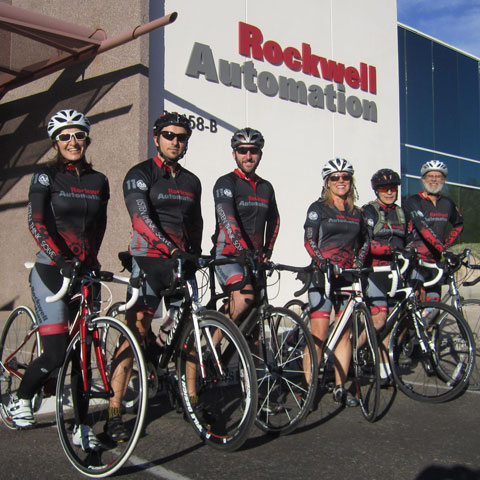
Featured in Photo: Lynn Folden, Adrian Pantea, Adam Patrick, Maureen Nowland, Roger Moore and Neill Thompson (l to r) sport their Rockwell Automation jerseys and shorts.
“We were all riding individually, so I said let’s do these afternoon rides again.” With that, the Phoenix bike club was reborn. Today, about 10 Rockwell Automation employees get together on Tuesdays and Thursdays and ride bicycles for about an hour and a half.
The group even ordered matching jerseys and shorts branded with the Rockwell Automation logo. “It’s cool when we’re out together,” said Adam. “We look like a team out there.”
Why a Bike Club?
The team says there are many benefits to riding together. “The biggest benefit is the motivation,” said Adam. “It’s easy to get lost in the work and stay here by the time the sun goes down. These rides are a reminder not to miss out on exercise.”
Plus, he notes, there’s safety in numbers. It’s easier for cars to see five riders versus one. And riding as a group can make new riders feel more comfortable. Most of all, it just makes it more fun. “I like the camaraderie of it,” said Adam. “It’s a pretty fun and casual group, and it reinforces the friendship aspect beyond the working relationship.”
Project Test Engineer and team member Neill Thompson adds that there are huge benefits to cycling in general—whether alone or in a group. “As a cyclist, I feel that I am helping myself, as well as helping the planet. I am personally healthier and when I commute, my cost per mile is negligible compared to the alternatives. But I am also reducing traffic congestion, parking problems, wear and tear on the roads, smog and greenhouse gasses, and energy consumption.”
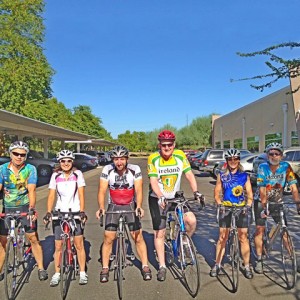
Featured in Photo: Will Klemovage, Lynn Folden, Adam Patrick, Steve Sheahan, Maureen Nowland and Neill Thompson (l to r) gather for their afternoon ride.
Adam can relate to the health benefits. Several years ago, Adam was in top shape—running marathons and participating in triathlons. Then a health issue caused him to take time off to reset. Since then, his focus has been on getting back to where he was physically. The cycling certainly helps. He also enjoys running and swimming, and he even completed the Escape from Alcatraz triathlon in 2013.
Making Time to Ride
“I started riding in my teens,” said Neill. “Now I try to make it part of my life. If it becomes routine, like brushing your teeth, it ceases to be a matter of choice and becomes a matter of habit. The key to making it automatic is making sure it is something you enjoy.”
Plus, Neill notes, cycling doesn’t really take up that much of his time. “On the days I commute to work by bicycle, I ride 36 miles round trip, but after subtracting the time I would have spent in my car, the commitment for the day is only about an hour. Multiply by two days a week and I get 72 miles worth of riding while only taking two hours of my time. That’s a bargain! Then, I ride a regularly scheduled three-hour group ride on Saturday mornings. Following this plan, I ride almost 120 miles per week and it only takes about five hours out of my week.”
An Open Invitation
The team welcomes new riders—of all levels, from recreational riders to racers—and encourages others to start similar clubs at other Rockwell Automation locations. And if you’re ever in Arizona, look them up.
“Phoenix is a great place as far as weather goes if you’re into biking,” said Adam. “My grand idea is for a big Rockwell Automation group to come out to Phoenix and we’d go riding together.”
This year the group plans on participating in two of the most publicized road bike races in Arizona: Tour de Scottsdale in mid-October and El Tour de Tucson in late November. “We welcome and encourage all Rockwell employees to participate with us,” said Adrian Pantea, another rider on the team.
My Wellness Story: Sue Burtch
Product Marketing Specialist Sue Burtch is happy to be a stronger, leaner version of herself these days. Here she shares what motivated her to take action, how she juggles work and family to stay on track and how it feels to weigh 35 pounds less.
What do you do to take care of your health and overall well-being? Why is it important to you?
I had knee surgery in 2012 for an arthritic knee, and after that healed I realized that I wasn’t getting any younger. I needed to take charge of my body so that I could be a fit mom and a good example for my kids, and I wanted to keep active to work around my knee arthritis pain as much as I possibly could. “A body in motion stays in motion!” I’ve also had essential hypertension since I was 20, and I was finally able to switch to a much lower dose of medicine this year.
How do you balance family time, a busy work schedule and taking care of your health?
I fit in exercise classes and personal training three days a week at lunchtime with Milwaukee Fitness Coordinator Kayla Coppernoll. I also swim at my health club on Thursdays while my daughter is at swim team practice. She recently trained for a triathlon, so we also rode bikes and ran on weekends. Exercise has become a family activity! My family has also started eating healthier with smaller meals, healthier snacks and more fruits and vegetables.
Describe in one sentence how you are feeling as a result of the changes you’ve made. Include how it has impacted your daily life.
I’m so much stronger and find that with my new muscles and 35 pounds (and counting) off, I am able to keep up with my kids and everyday tasks are so much easier. Now I don’t mind parking in a spot that’s far from the door, and no more panting after climbing one flight of stairs! I have also found that I have been able to translate my determination to improve myself to other areas of my life.
What tools or resources (e.g., an app, pedometer or Take Action activity) do you use to help support your health goals?
I started out in fall of 2012 with the Choose to Lose weight-loss program at Rockwell Automation. I also take advantage of lunchtime fitness classes and personal training offered in the Milwaukee fitness center. I use the Lose It! app to track my food and exercise, and I wear a Fitbit activity tracker every day. My Fitbit automatically synchronizes with our Step It Up challenge, so I don’t have to manually log my steps.
What is the last red vegetable or fruit you ate? Why?
Red peppers in some chicken fajitas. Why? Because they’re delicious!
What inspired you to share your story?
Kayla says I’m one of her favorite success stories! She taught me how important it is to include weight training in your workouts, and that has made all the difference for me. Having the fitness resources at Rockwell Automation has been so valuable for me, and I want others to know that they’re available. [Editor’s note: If you don’t have a fitness coordinator at your location, consider working with a health coach.]
What message do you have for someone looking to make healthy living a part of his or her daily life?
It’s a long road, and there are no shortcuts that will work in the long term. I try to do something active at least six days a week, and I have to remember never to stop doing that. At the same time, with my high level of activity, I’m able to enjoy treats like pizza and frozen yogurt without worrying—as long as it’s occasional. It’s really about the long-term, day-to-day choices. If I make good choices and exercise most of the time, there is room for fun and indulgences—that’s a good balance!
Your Turn!
Thanks to Sue for sharing her story. Now we want to hear from you! What are you doing to stay active, eat better or relax more? Let us know by completing this form. (Don’t worry. You don’t have to answer every question.) Just tell us what motivated you to take action, what you’re doing now to keep it up and any outcomes you’ve seen so far.
Published: May 9, 2014
Where Are They Now?
Need inspiration? These Rockwell Automation employees prove that once you find a physical activity you love, you’ll stick with it. They first shared their stories with us years ago. We enjoyed learning how they got started, stayed motivated, improved their health and earned incentives. So we decided to follow up to see where they are on their fitness journeys now.
Kevin Jones
Senior Sales Engineer (Spokane, WA)
Then: Despite a hip replacement and back surgeries, Kevin remained an avid mountain climber, leading several groups up Washington’s Mount Rainier and climbing several peaks. When we last spoke to him, he was training to climb Mount Everest, the world’s highest mountain.
Now: Kevin made it to Everest, but a potentially life-threatening blood clot prevented him from reaching the top. Although he dreams of returning to Everest, he’s focusing on other activities while he rehabilitates after a second hip replacement. “I still work out every day, and I’m on my bike three or four times a week,” he said.
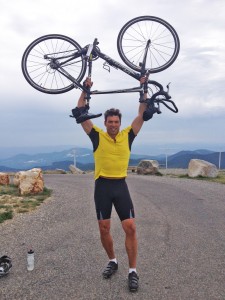
In fact, Kevin just completed a 100-mile bike ride and plans to ride from his house in Spokane to the Space Needle—a 300-mile trip he says will take him two or three days to complete. “I love fitness, and I love a challenge. I always want to feel like I have a goal,” he explained.
After his surgery, Kevin is able to play tennis again. “I’m getting back to myself and starting to feel like I did 10 years ago,” he added. For anyone dealing with an injury or any other obstacle to exercise, Kevin says to not give up. “When you’re hurt, you have to fight that tendency to let that one injury ruin your goals,” he noted. “You can adjust to injuries, time management, work stress, family management. It’s a matter of discipline to find reasons to do it and stay healthy.”
Bob Chesla
Senior Project Engineer (Mayfield Heights, OH)
Then: After receiving a bicycle for Father’s Day, Bob got in shape by riding on every street in his city. Along the way, he lost 6% of his body weight thanks to the cycling, diet changes and walks with his wife.
Now: Having explored his city, Bob now spends his free time riding along Ohio’s iconic Towpath Trail. “My goal is to complete the sections from Lake Erie through the Cuyahoga National Park and then through several counties,” he said. This time, Bob has company. “My wife and three sons now have bikes, and we ride together when we get the opportunity.”
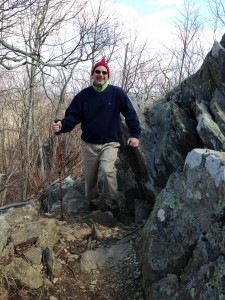
Bob has also started hiking. He and two of his sons even took a three-day hiking trip to the Shenandoah National Park up in the Blue Ridge Mountains of Virginia. When winter weather kept him off the trails, he and his wife stayed active by remodeling their house. “Working with a contractor, we ripped out everything from our master bathroom and took it down to the studs. We’ve started from scratch with doing plumbing, electrical wiring, concrete work, subflooring, tile, drywall, waterproofing, ceiling and the fixtures,” he said. “It’s proven to be quite the workout for us.”
Looking back, Bob says these activities helped him improve his health screening numbers over the past two years. But more importantly, they’ve created bonding experiences with his family that he’ll cherish forever.
Steve Smith
Editorial Content Manager (Milwaukee, WI)
Then: A couple years ago, a group of Rockwell Automation employees—including cycling enthusiast Steve Smith—joined the National Bike Challenge, a program that encourages biking for transportation and recreation.
In just three months that year, the team logged 52,007 miles commuting to work—enough miles to circle the earth two times!
Now: Steve is still racking up those miles. A busy father of three teenagers, Steve says bicycle commuting is a great way to fit physical activity into his day. It also provides an excellent foundation for his competitive pursuits. “Riding to work (20 miles round trip) up to four times a week gives me great fitness,” he said.“I posted my fastest time in the Chequamegon Fat Tire 40 mountain bike race this past year (after 20 consecutive years riding the race) and had my best finish in the American Birkebeiner cross country ski marathon in February!”
Your Turn!
We’d love to hear your story! What are you doing to stay active, eat better or relax more? Let us know by completing this form. (Don’t worry. You don’t have to answer every question.) Just tell us what motivated you to take action, what you’re doing now to keep it up and any outcomes you’ve seen so far. If you’re up to it, upload a picture, too.
Published: April 10, 2014
Employee Feature: Julie Burke
Julie Burke handles MS the way she handles her job: one step at a time, and always moving forward.
Julie Burke, sales engineer in Greenville, S.C., was shocked by the diagnosis: multiple sclerosis (MS).
MS is an unpredictable and often disabling disease that disrupts the flow of information within the brain, and between the brain and body. It explains six years of on-again, off-again debilitating symptoms.
While physically challenged, MS was hardly Julie’s first or biggest lifetime trial—and she was not going to let it change her goals or her outlook. If anything, it has made her more patient and empathetic.
“MS has helped me appreciate and understand what other people are experiencing,” she said. “Now when I am talking to customers, colleagues and distributors, I am more conscious about what might be happening in their lives that could be influencing our interaction.”
Although proving to be a tough physical challenge—some days Julie finds it hard to get out of bed—she is determined to stay physically active. She completed her first half-marathon (13 miles) just a few months ago while three months pregnant; she completed a 50-mile MS fundraising walk while six months pregnant.
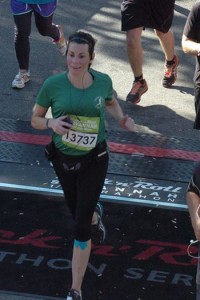
“Julie is a great example for perseverance, commitment and community awareness—in both her work and personal life,” said Michelle Keough, specialist, Commercial Sales.
Julie has a 23-year-old daughter, Lauren. Julie is also mom to a two-year-old son, Declan, and is expecting a baby girl, due on May 29.
“Having a child so young was one of my biggest challenges,” Julie said. “People said I wouldn’t graduate from high school. I did. I wanted to study chemical engineering in college, and a professor told me the courses were too hard for a single mom, I should transfer to another school and change my major. I determined then that if someone told me I couldn’t do it, I simply would prove them wrong.”
That willpower comes in handy now, when Julie’s mind must overcome her body.
“In my job, I have dynamic and unpredictable days,” she said. “I’ve learned to roll with whatever comes my way; now I apply that same methodology to my illness. If my body says I can’t keep my meetings that day, I tell myself just make it out the door and to the first meeting and if I can’t keep going, then I can reschedule. Then I make it to the next meeting. And the next. Then I look back over the day and realize that I made it, even though I didn’t think I could. That accomplishment encourages me to keep moving forward.”
That’s exactly the attitude Julie applies to running. “Most days I don’t think I can go a mile, much less 10,” she said. “More than saying ‘I won’t give up’ I tell myself, ‘I just have to start.’ That thinking helps me succeed at work as well.”
Julie finds strength and inspiration in knowing that she might not always have the physical strength she has now, so she must always remember to ‘use it or lose it.’
“I appreciate everything I can do now, and I know I might not be able to do these things tomorrow,” she said. “When one doctor told me I should stop running, I decided to run longer than I ever had before and completed my first half-marathon.”
Inspiring others
“I want people to know that they don’t have to settle,” said Julie. “Just because you have a disability, don’t ever let anyone tell you what you cannot do. You just never know what you can do until you try. You will always regret not trying more than trying but not succeeding.”
Julie appreciates the company’s support and said her colleagues have been extremely kind and compassionate. “They offer help wherever possible and make sure I know that my health is a priority,” said Julie. “For my Challenge Walk MS, employees had a huge impact on my bottom line. Collectively, they donated a total of $3,100 to my cause.”
You can learn more about Julie’s efforts on her ‘Running From MS’ Facebook page.
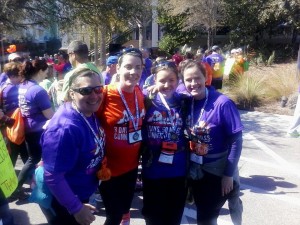
Employees helped Julianne raise more than $6,000 toward her team’s total of $11,123! Julianne’s team was awarded the Rookie Team of the Year award for being small but mighty. No other team of only four people came close to the team’s totals.
Published: April 4, 2014


